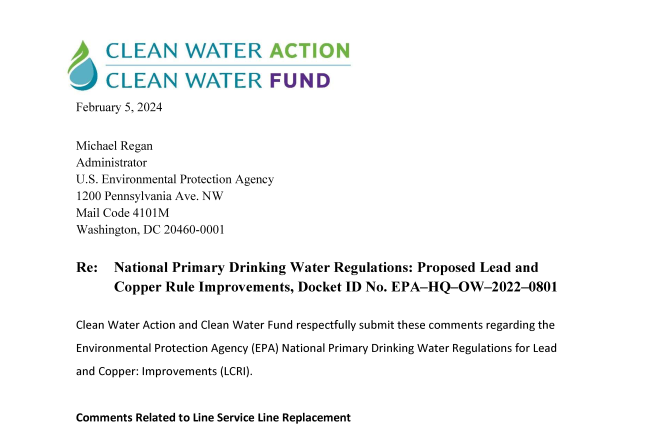
Lead is a highly poisonous metal and can affect almost every organ in the body and the nervous system. It is a naturally occurring element found, due to human activity, in all parts of our environment. People can be exposed to lead through inhalation, ingestion and to a lesser extent, dermal contact. Because they absorb more lead than adults and because their brains and nervous systems are still developing, children under 6 and the developing fetus are most susceptible to lead exposure. The most common source of lead exposure is ingestion of old lead paint. The U.S. Environmental Protection Agency (EPA) estimates that lead in drinking water can be 20% or more of a person’s lead exposure.
Further reading
- Download our printable fact sheet (descargar en español)
- Learn more about the Federal regulation of lead in drinking water
- Read the Lead Service Line Replacement Collaborative's Case Study on Clean Water Action in Chelsea, Massachusetts
- View updates, publications, and actions on our Lead and Drinking Water Campaign Page
Getting the Lead Out: To protect public health, we must reduce lead exposure at the drinking water tap.
To make this a reality Clean Water Action and Clean Water Fund are:
- Advocating for proper implementation of the Safe Drinking Water Act’s Lead and Copper Rule (LCR), including effective “corrosion control” at drinking water treatment plants to prevent lead leaching out of pipes and plumbing fixtures and monitoring to assess lead in water systems.
- Working and advocating for improvements in the LCR by the US Environmental Protection Agency.
- Supporting communities and water systems in replacing lead service lines and taking other steps to get lead out of contact with drinking water.
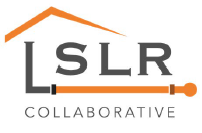 The Lead Service Line Replacement Collaborative
The Lead Service Line Replacement Collaborative
Clean Water is working with the Lead Service Line Replacement Collaborative to provide tools for communities that are interested in full lead service line replacement. Getting lead out of water requires increased attention from government at all levels, water systems, and consumers:
- We need to make sure water treatment is reducing the corrosion that can result in lead leaching out of pipes and plumbing.
- We need robust monitoring and transparency in sharing sampling results.
- We need consumers to know about actions they can take to reduce exposure to lead in water.
We need to get lead out of contact with water. That’s where full lead service line replacement comes in. The Lead Service Line Replacement Collaborative came together to assist communities that are considering a replacement programs. A collaborative community-wide approach has multiple benefits:
- Stakeholders can work together to decide if a full replacement program is right for their community.
- A collaborative approach can make it more likely that communities will tackle financial and logistical challenges.
- Elected officials, government employees, water systems, public health professionals, and consumers coming together can lead to new commitments to address childhood lead poisoning and other urgent public health issues.
For more information about the Lead Service Line Replacement Collaborative visit this page.
Brief history of Lead
Lead has been used for thousands of years, and has historically had many uses due to its ease of extraction and malleability. Lead was commonly used to make water pipes and for many other uses in the Roman Empire. In the Industrial Revolution, new uses for lead emerged; including lead based paints, and leaded gasoline. As the scale of lead use increased, so did the understanding of health risks, eventually leading to a decrease in lead use for many common uses .
Human Exposure and Impacts on Health
Lead exposure can occur through inhalation, ingestion and to a lesser extent, dermal contact. The most common way people are exposed is from ingestion of old lead paint. As the paint ages, it peels and breaks down into dust, then enters the body through hand to mouth contact or contamination of food or water. There are also risks of workplace exposure in fields that may come into contact with lead, including, but not limited to the construction, manufacturing and solid waste/recycling sectors.
Health impacts of lead:
- Children under six are most at risk from lead poisoning.
- Exposure to high levels of lead can cause severe damage to the brain, blood and kidneys.
- Even low levels of lead exposure have been found to permanently reduce cognitive ability and cause hyperactivity in children.
- Long term exposure can cause reproductive harm and infertility.
- Pregnant women are susceptible to lead, as exposure can harm the fetus, reducing growth rates and causing premature birth and/or miscarriage.
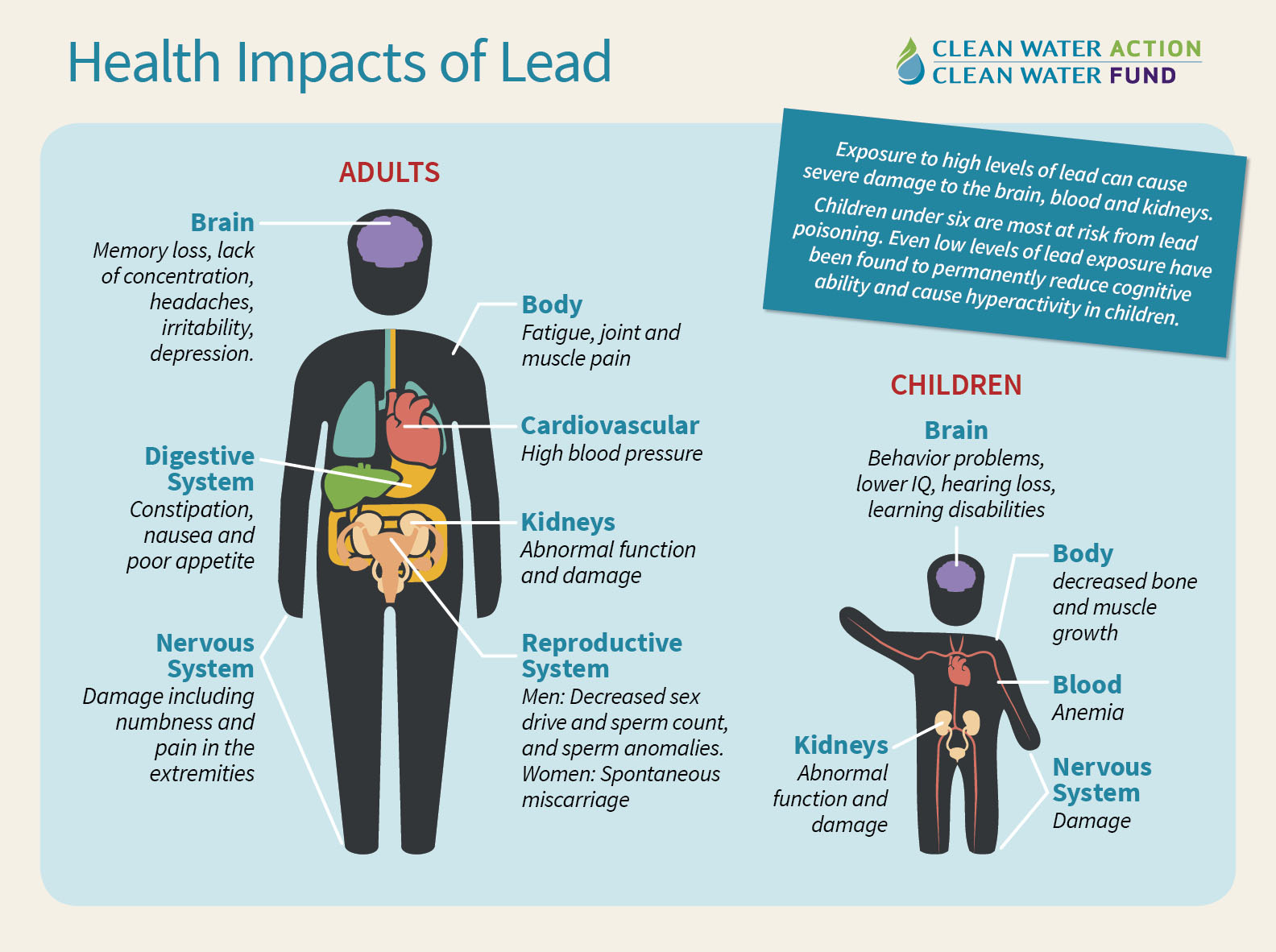
Why is lead in drinking water?
Exposure to lead from drinking water is less common than other pathways yet, as demonstrated in Flint, MI, can have serious consequences. Lead can enter drinking water when service lines, pipes in the home and other plumbing fixtures, or solder that contain lead corrode. Older homes, especially those built before 1986, are more likely to have lead service lines, fixtures and solder. However, even newer “lead-free” fixtures could contain up to eight percent lead until 2013.
Lead, unlike many other drinking water contaminants, is usually not present in the drinking water source, but rather results from the distribution system or on site plumbing itself. Lead gets into water at the tap when water with “corrosive” chemistry comes into contact with lead in pipes, fixtures, and solder.
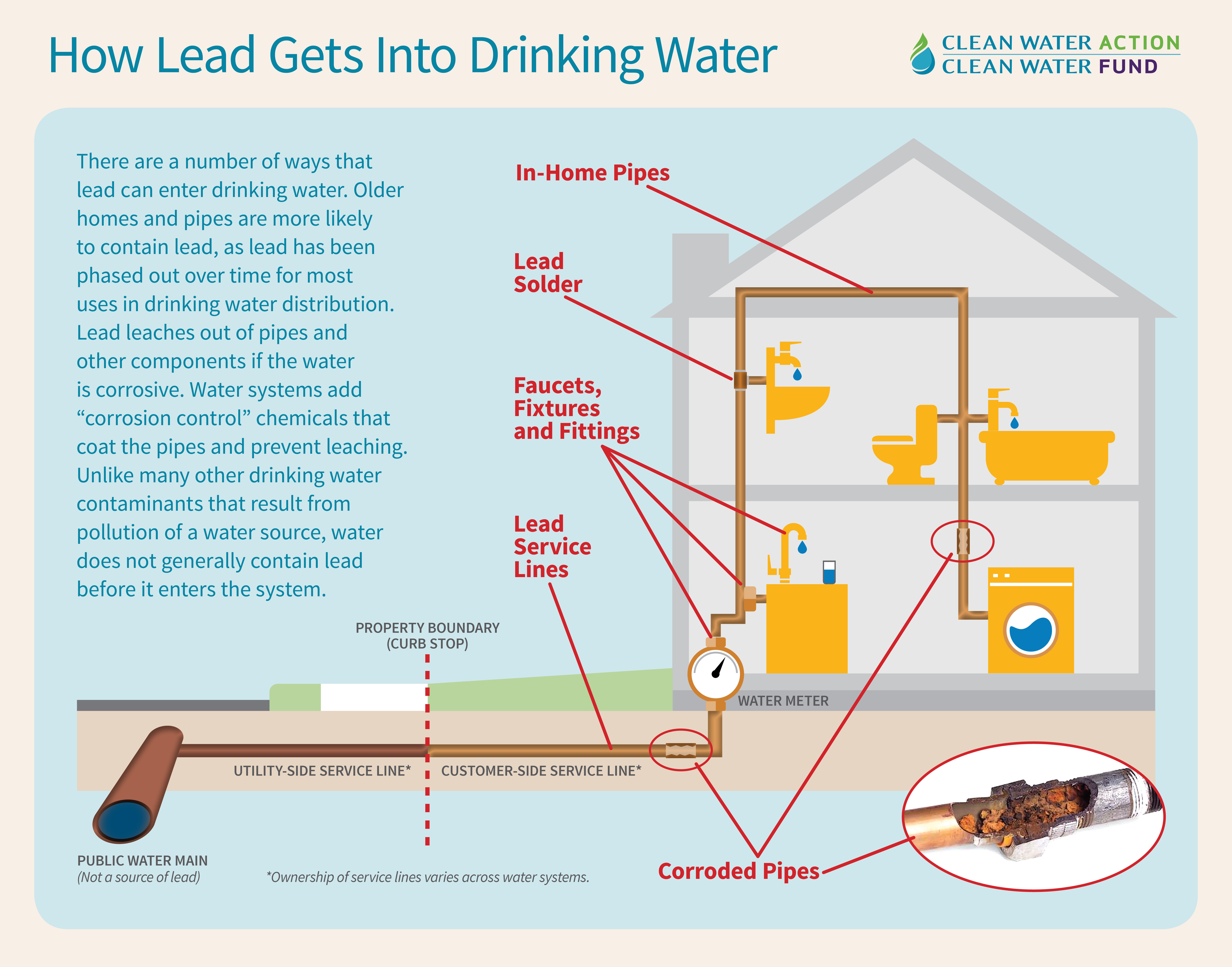
Reducing Lead at the Tap
There are a number of ways that water systems work to reduce lead in drinking water:
- Stop using lead pipes, fixtures and solder: Current regulation requires that all new pipes and fixtures be “lead-free” - containing less than 0.25% lead (weighted average).
- Replace lead service lines: There are roughly 6 million lead service lines (LSL’s) in the US. Roughly 30% of the country’s water systems contain LSL’s, serving an estimated 15 to 22 million people. Many water systems have taken steps to remove LSL’s and since the Lead and Copper Rule was adopted in 1991. The number of LSL’s has been reduced by roughly 40%.
- Reduce corrosion and check water chemistry: A critical part of modern drinking water treatment is minimizing corrosion to keep lead out of drinking water and to address other issues. Corrosion Control Treatment (CCT) is especially important where there are LSL’s. CCT varies from water system to water system based on the age of pipes and service lines, where the drinking water comes from and its chemistry, and the size of the system.
How to protect yourself from the impacts of lead:
- Learn about lead levels in your community. Every year, public water systems prepare a Consumer Confidence Report (CCR), which includes information on lead monitoring results. For more information and help finding your CCR: https://www.epa.gov/ccr. Water systems also post lead monitoring results online.
- Run your water before drinking or cooking. The longer water sits in pipes, the more lead it may contain. When water has not been used for 6 hours or more, running water 1–3 minutes until it becomes cold can help ensure you are not using water that has been sitting in the pipes. This water can be used for watering plants or other non-consumption uses.
- Have your water tested. If you are concerned about lead in your tap water you can test for lead and other contaminants. Some water systems will provide lead testing for their customers. Others will provide information on local laboratories and other resources. There are low cost tests available. Call your water system to see if testing is available.
- Use cold water for drinking and eating. Cold water is less likely to contain lead. Never add warm water to baby formula. Boiling water will not remove lead.
- Choose the right filter. Only specific products are designed to reduce lead contamination. If you choose to use filters, consult your water system and learn more about products here.
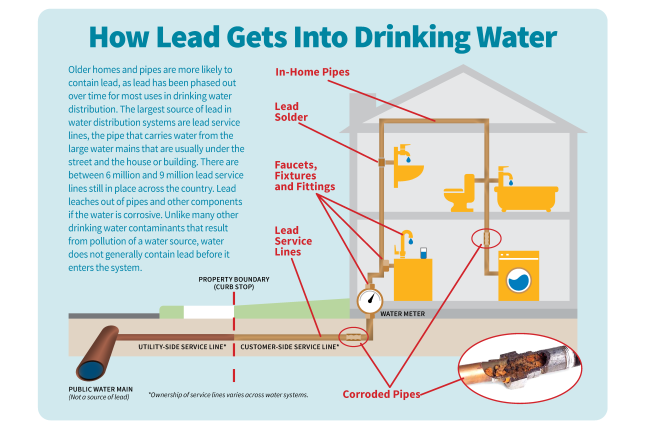
Factsheet: Lead and Drinking Water (English & Spanish)
